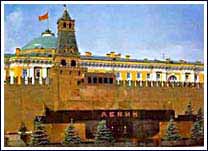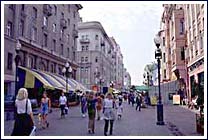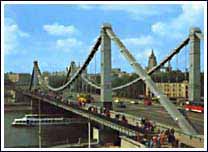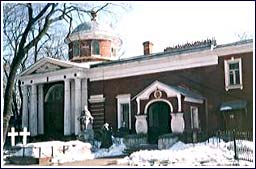Form
in Russia
Moscow

The Lenin Mausoleum
The first tribes of people appeared in the territory of the future Moscow in the Neolithic era. The oldest settlements, dated three thousand years before our era, were discovered within the area of the present-day city. In the second half of the first millennia of our era, Slavic tribes occupied areas near Moscow; these were the "vjatichi", who are regarded as a kernel of the future Moscow population.
A reference to Moscow, as a town, is recorded in an old manuscript of 1147. In 1156, Prince Yury Dolgoruky erected timber walls around Moscow along with a moat. He is frequently regarded as a founder of Moscow, and his monument is among the most honoured in Moscow. The Tatar-Mongolian invasion in 1237-38 produced great destruction of Moscow. However, Moscow recovered rather rapidly (in the second half of the 13th century), and became the capital of the independent Moscow principality.
During the 14th and first half of the 15th centuries Moscow was a relatively large city with a big industrial/trade population. At the end of 15th century, under Ivan III, Moscow became the capital of Russia. In Moscow, the Kremlin was built in the beginning of the 15th century, and is a benchmark of that era. For the purpose of improving the defence of Moscow and of its inhabitants, a number of defence buildings and big clusters, like Novodevichy in the southwest, Donskoy and Danilovsky in the south, Simonov and Novospassky in the southeast and Andronnikov in the east, were constructed.

The Arbat
The development of commerce and trade served as an impetus for new advances in the sciences and arts. So, a number of fundamental manuscripts, great architectural buildings and the first Russian printed book, "Apostol" by Ivan Feodorov were created.
Moscow was attacked by the Polish-Lithuanian army in the 17th century and was conquered by them. Then the salesman Minin and the Prince Pozharsky organized the People's Militia, and Moscow was liberated in 1612.
During the reign of Peter the First, arts and science in Moscow, as well as the whole of Russia, progressed strongly. In 1703 the first printed newspaper "Vedomasti" appeared, and in 1755 Moscow University was opened.
Moscow architecture reached its peak level of perfection in the second half of the 18th century due to advanced Russian architects, such as V.I. Bazhenov's the (Pashkov's house), and M.F. Kazakov's (Senate building).
In the 19th century Moscow remained an important political, governmental and economic centre. During the French invasion Napoleon said: "If I capture Kiev, I take Russia by its feet, if I capture Petersburg, I take it by its head and if I capture Moscow, I destroy its heart".
A folk army had been organized in 1812 to withstand the French invasion. The famous Borodino battle took place in August not far from Moscow. This battle is thought to be a prerequisite for the victory in the war, although the battle itself was more a failure than a victory. Moscow was left to Napoleon's troops, but before that happened, Muscovites burnt Moscow almost entirely. Fires and hunger compelled the French army to leave Moscow, which the Russian army entered in October. After the liberation of the city a commission was authorized for the reconstruction of Moscow after the fire, and talented architects were its members (Beauve, and Grigoriev).
The present-day appearance of the centre of Moscow was founded in those times.

The rivers and bridges of Moscow
The rivers and bridges of Moscow, the, Alexandrov Garden, and Theatre Square appeared with the Bolshoi and Maly theatres, as well as the buildings of Manezh and the first gradskaya hospital.
A new manner of living became the norm in Moscow after its reconstruction. Earlier, at the turn of the century, Moscow was a feudal town, whereas after 1812 it lost the features of an aristocratic town and acquired those of a bourgeois one. Towards the end of the 19th century it became the second industrial centre in Russia (after St. Petersburg), partially due to the rapid growth of railway communication.
The first telegraph line was constructed in 1852, it connected the two Russian capitals, and the town railway with horses ("konka") started operating in 1872. In 1867 gas illumination of many streets had been initiated, and the first electric lanterns appeared in the Prechistenka gates in 1883. The first telephone lines were strung between Moscow and Petersburg in the late 1890's.
The 19th century was known to be a "golden age" for arts and science, and Moscow was the birthplace for many famous artists, writers, painters and scientists; a number of outstanding politicians were also Muscovites. You are, of course, familiar with the following names, whose talent and ideas were the glory of Russia: Pushkin, Gogol, Tolstoi, Chekhov, Herzen, Pirogov, Sklifosofsky, Vasnetsov, Serov, Levitan and many others.

The Don monastery
Communistic ideas of Karl Marx became popular in Moscow, workers and intelligentsia, who became very enthusiastic about them and organized revolutionary groups, studied them in secret meetings. Their activities resulted in a series of rebellions, one of them was mentioned frequently as the most successful "The Krasnaya Presnya" rebellion of 1905. The July strikes of 1914 were the next conspicuous stage in the revolutionary process, which was finalized in February and the "Great October" Revolution of 1917.The new government was headed by V. Lenin and the capital was again transferred from Petersburg-Petrograd to Moscow. The Soviet Union was announced December 30, 1922 by the All-Russia Communist Party of Bol'sheviks (VKPB) and Moscow became its capital. The social structure of Moscow's inhabitants started to change in the 1920-ies becaause of peasants leaving their villages in search of jobs and a "new life"; later on the poorest part of the population came to Moscow as non-qualified workers in factories and in house construction. Thus, the percentage of workers living within the Garden Ring (central region) increased from 5% to 45% during this first decade. Hence, Moscow architecture changed: the proportion of blocks inhabited by workers increased drastically; the city sprawled outside, many churches were destroyed or transformed into "Palaces of Culture", clubs, stores for vegetables or for building materials. Nikita Khruschev initiated the most active construction of housing blocks in the 1960's, and many families moved from extremely overcrowded multi-family apartments, where more than 5 people were living in one small room to individual, although small apartments. They were constructed quickly to meet the urgent demands, and, therefore, they are far from being beautiful and diverse.
Fiancee Visas!
Fast - Full Service
 Let A Foreign Affair and Attorney Jones handle all your Fiancee Visa and Immigration matters
Let A Foreign Affair and Attorney Jones handle all your Fiancee Visa and Immigration matters
- Faster Overall Processing
- 100% success rate
- Fluent in English and Russian
- Vice Chair of the Immigration Section of the State Bar of Az
www.fiancee-visa.com

Join Our
Hair Health Romance & Vacation Tour!
Take a wonderful and romantic vacation to the foreign destination of your choice, enjoy meeting hundreds of beautiful marriage minded women and obtain the hair loss restoration, replacement, transplant or treatment of your choice.
Restoration of hair loss or treatments to stop hair loss have never been so much FUN for men world wide!
hairtransplanttours.com
Welcome to A Foreign Affair!
View thousands profiles with photos of beautiful and marriage minded Russian, Ukrainian and Latin women.
Join our unforgettable Romance Tours to Russia, Ukraine or Latin America and meet 500 to 2000 Beautiful Foreign Women.
A Foreign Affair offers more Romance Tours to more cities than any other tour company.
www.loveme.com



